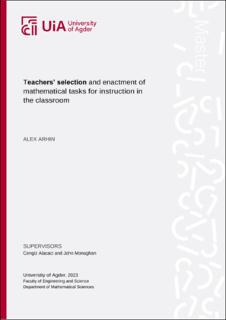| dc.description.abstract | Researchers have revealed that most of the hours spent in mathematics lessons are used for
solving mathematical tasks. A mathematical task is defined as an individual problem or a set
of related problems that direct students’ attention toward a particular mathematical thought.
There have been significant changes in the mathematics school curriculum in many countries
with Norway not being an exception. For example, fewer mathematical concepts are being
taught deeply in Norway to stimulate conceptual understanding rather than just a shallow
treatment of mathematical concepts. Also, the importance of teaching and learning
approaches to motivating students to be active learners is emphasized in the curricula. The
importance of students acting independently and taking responsibility for their learning is
also highlighted. These changes have prompted the adoption of proper methods in the
teaching and learning of mathematics, and the use of good mathematical tasks has been
identified as one of the vehicles needed to drive these changes.
This research aims to investigate how mathematical teachers select and enact mathematical
tasks in their classrooms by looking at the sources of the tasks they use, the cognitive demand
of the tasks, the factors they consider when they are choosing the tasks, modifications they
make to the tasks, if any, and why they make modifications to the tasks, if any, and finally the
interactions in the classrooms that may change the cognitive demand of the tasks. In this
study, a total of twenty-three teachers from the southern part of Norway were selected to
participate in the study with three participants selected to participate in the case study and
twenty others in the survey. The sources of empirical data for the study were interviews,
classroom observations, curriculum documents (for the case study), and survey
questionnaires (for the survey).
The findings of the study suggest that even though there is a plethora of resources/sources
that the teachers get tasks from, the predominant of them is the textbook. Other major sources
of tasks are mathematikk.no, and ndla.no, which are internet resources. Aside from the use of
the resources as sources of tasks, other dominating uses of the resources include lesson
planning and making instructional explanations. The findings indicate that most of the tasks
used by the teachers are at the lower level of cognitively demanding tasks as per the task
analysis guide of Stein and Smith (pg.16). The findings again show that the major factors that
teachers consider when selecting tasks include tasks that stress on mathematical ideas,
focuses on the students, and have applications to other topics. Furthermore, the findings
iv
revealed that even though the tasks selected by the teachers were lower-level tasks, however,
the teachers did not modify the individual tasks to make them more challenging for the
students. According to the teachers, the tasks were many and good, and served as a guide for
the exams are some of the reasons why they did not modify the individual tasks. Moreover,
the set of tasks was sometimes modified to reduce the time needed to complete them and
make them suitable for the students. Lastly, the findings indicate that the instructional habits
and dispositions of the teachers and the students in the classroom reduced the cognitive
demands of the tasks.
As a didactical implication, Teachers are advised to re-design or modify textbook tasks to
offer the opportunity for students to develop deeper mathematical thinking. Furthermore,
teachers must set goals they want to achieve with the tasks and stick with them. If the goal is
for the students to work with the tasks at the highest level of difficulty, then they are advised
to use indirect ways to participate in the students thinking rather than getting directly
involved. Future research must explore the relationship between students and mathematical
tasks.
Keywords: mathematical tasks, mathematical task selection, tasks modifications, cognitive
demand of mathematical tasks | |
